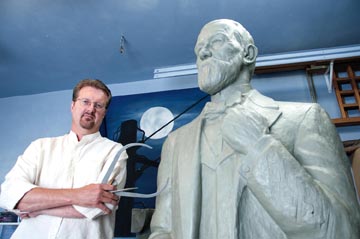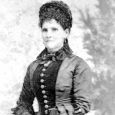The Gift of South Dakota
Subscriptions to South Dakota Magazine make great gifts!
Subscribe today — 1 year (6 issues) is just $29!
Pettigrew's Redemption
Might a sculptor vindicate Sioux Falls’ forgotten father?
 |
| Darwin Wolf (above) wanted to honor Sioux Falls city father Richard Pettigrew through sculpture, but his project soon became a way to vindicate the reviled businessman and politician. |
Richard Pettigrew sat at his writing desk in the second-floor study of his home at Eighth and Duluth in Sioux Falls and penned a letter to the city’s leaders. The town he helped build was quickly becoming South Dakota’s urban giant, but Pettigrew urged them to leave a strip of land near the falls of the Big Sioux River undeveloped. He believed it should become a park.
But by then, Pettigrew, one of the fathers of Sioux Falls and South Dakota’s first full-term United States Senator, was a washed up politician known for unpopular stances, failed businesses and crazy ideas. City leaders ignored his advice. Soon a salvage yard, warehouse and railroad moved in. The buildings remained hollow shells long after the businesses themselves left, and since the early 1990s, the city has been transforming that land into a park as part of its multi-million-dollar Phillips to the Falls project.
Pettigrew’s concern for preserving the river environment contradicted ideas he had held as a young businessman. Years earlier, he led a group of investors in building a stockyard and meat packing plant along the Big Sioux River in south Sioux Falls. They had a plan for everything except removing waste, so they simply dumped it into the water. Townspeople obtained a court injunction closing the plant, and Pettigrew and his investors lost over $1 million.
So was Pettigrew a visionary or a scoundrel? A bona-fide town builder or self-serving politician? Was he a Republican, Populist, Democrat, Socialist or Communist? At times in his life he was all of the above.
One thing is certain: following his death in 1926 many in Sioux Falls chose to forget rather than memorialize the polarizing Pettigrew. Darwin Wolf hopes a sculpture will change the city’s attitude toward its long-forgotten pioneer. In 2003 Wolf began planning a larger-than-life Pettigrew bronze. “How many great cities in the country have sculptures of their pioneers somewhere in the community, and we don’t have a Pettigrew,” Wolf says. “It began more out of my love for Sioux Falls than Pettigrew. It just seemed like there was a hole in Sioux Falls.”
Few lifelong Sioux Falls residents would have shared Wolf’s opinion, but the sculptor is an outsider. Born in Doland, he grew up in Aberdeen and studied art at Northern State University. He worked at Stein Sign Display there for five years after graduation, doing sculpture on the side, but soon realized he needed a more stable job to support his growing family. In 1988 he moved to Sioux Falls and spent the next 15 years in sales and marketing.
In 2003 St. Therese Catholic Church commissioned him to sculpt “St. Therese and Admirers,” for the church’s rose garden. About the same time, he won a competition to do a bronze for Avera Health. The projects led him back into a full-time art career. East River South Dakotans may recognize his work. His bronze of Monsignor John McEneaney stands at McEneaney Field. St. Joseph and two children are at St. Joseph Indian School in Chamberlain.
Wolf researches each subject before he ever picks up a knife in order to sculpt an appropriate likeness. When South Dakota Magazine visited his home studio in 2010, a pile of Pettigrew photographs sat atop his table. Wolf used one to shape the eyes, another the nose, a third the forehead and so on. When finished, the bronze will depict Pettigrew as an elder statesman. Dressed in a full suit, his left hand is clenched tightly around his lapel, symbolic of his fight for agrarian interests in the Senate. His right hand clutches the letter he wrote about preserving land along the river.
But Wolf’s research on Pettigrew has gone beyond a pile of photos and a few biographical tidbits. “It really sucked me in,” he says. “The more I learned, the more I found that I liked and disliked. There’s always another story about him, and it’s tough to figure out what’s true and what’s not. He was such a tenacious fighter and did so many good things for Sioux Falls, the monument evolved into being a project for some redemption. His aggression and passion for Sioux Falls and South Dakota cost him dearly.”
So was Pettigrew a visionary or a scoundrel? A bona-fide town builder or self-serving politician? Was he a Republican, Populist, Democrat, Socialist or Communist? At times in his life he was all of the above.
Sioux Falls was beginning its second life when Pettigrew arrived with a surveying crew in 1869. Founded a decade earlier, settlers abandoned the town site during the Sioux Wars of the early 1860s. They returned after the U.S. Army established Fort Dakota (along today’s Phillips Avenue between Seventh and Eighth streets) to protect pioneers from Indian attacks. Pettigrew claimed 160 acres and returned permanently the following year, intent on making the village of Sioux Falls succeed.
Sometimes his ambition trumped compliance with the law. In 1870, already with an eye on politics, he told people living within Fort Dakota that they could claim land within its boundaries as soon as the land was surveyed. Pettigrew and Nyrum Phillips circulated a petition asking Congress to open the reservation, but too few people lived within Minnehaha County to sign it. So the two added names of men they thought would soon settle in the county, and sent it to Washington. Congress soon complied.
Shady actions clouded his first successful run for the territorial House of Representatives. Before the election, Pettigrew destroyed a number of ballots that had omitted his name and sent a new batch to some northern counties. As it happened, many of Pettigrew’s votes came from non-resident railroad workers laying track into the new town of Gary. Pettigrew was never charged and took his seat in the House, but the “Deuel County Fraud” accusations haunted him the rest of his life.
While in the legislature, he helped make Sioux Falls the seat of Minnehaha County and wrote a bill creating Lake and Moody counties. To his own benefit, Pettigrew ensured that Flandreau became the Moody County seat. He and his brother, Fred, owned large tracts of land there. He later served a term as Dakota Territory’s delegate to Congress in the early 1880s, where he helped secure funds to build the state penitentiary.
Pettigrew was also a strong proponent of division of Dakota Territory and statehood for the southern half, a cause that endeared him to people living south of the 46th parallel (roughly today’s North Dakota/South Dakota border). When South Dakota gained state-hood in 1889, the legislature elected the Republican Pettigrew the state’s first full-term U.S. Senator.
In that role, Pettigrew secured funding for some of Sioux Falls’ landmark buildings, including the federal courthouse and post office building (which he insisted be built from native Sioux quartzite) at 12th Street and Phillips Avenue. He also balanced business with his political life. He helped bring five railroad lines into Sioux Falls and formed a railroad and trolley company with his brother. His biggest dream was creating a transcontinental railroad running from Sioux Falls to Seattle.
Unfortunately, most of his business investments happened during the economically turbulent 1890s. The trolley went bankrupt and the rail line to the West Coast fell through. It marked the beginning of a drastic change in Pettigrew. He began to question capitalism and lost trust in the country’s business leaders, many of whom comprised the core of the Republican Party. Pettigrew saw a solution to the country’s economic woes in the free and unlimited coinage of silver, and in 1896 he bolted the Republican Party to become a Silver Republican and, eventually, a Populist.
The move put him at odds with President William McKinley. Pettigrew was a vocal opponent of the Spanish-American War, despite strong support across the country. He was also an outspoken anti-imperialist, opposing the United States’ annexation of the Philippines and the Hawaiian Islands. Pettigrew openly criticized the president and U.S. military leaders. He called the American flag a “rag,” a comment not well received in South Dakota. Pettigrew became such a thorn in McKinley’s side that Ohio Sen. Marc Hanna, McKinley’s presidential campaign manager in 1900, said he had two goals that year: to re-elect McKinley and defeat Pettigrew, “and I did not know which I wanted worst.” He got both. A well-organized fund-raising drive within the national Republican Party pumped nearly $500,000 into the South Dakota campaign, and Pettigrew lost his bid for re-election.
Pettigrew joined the Democratic Party and split time between Sioux Falls and New York City. In 1912, he supported the Progressives and their presidential candidate Theodore Roosevelt. After Roosevelt’s defeat, Pettigrew’s politics became even more radical. He flirted with Socialism and Communism and wrote two books — a collection of his Senate speeches called The Course of Empire, and Imperial Washington, praised by Soviet leaders Vladimir Lenin and Leon Trotsky. He died at his home in Sioux Falls on Oct. 5, 1926, and was entombed at Woodlawn Cemetery.
Pettigrew lost favor with nearly every influential business and political leader in Sioux Falls. Negative stories persisted for decades. The only physical reminder of Pettigrew was his home and museum, which he willed to the city, and even that was nothing more than a hodgepodge of artifacts with no interpretation, remembers Wayne Fanebust, Pettigrew’s biographer.
Fanebust grew up in Sioux Falls during the 1940s and ’50s, when no one talked about Pettigrew. “Had there not been the Pettigrew home and museum, I would have known nothing about Pettigrew, and no one else would have known anything,” Fanebust says. “He wanted to be remembered, and until the professionals at the Siouxland Heritage Museums took control, it was a pretty sad affair. It was like an old curiosity shop. It really didn’t explain his life at all. He was lost to the community for a long time after his death.”
But Fanebust rediscovered Pettigrew in California. After graduating from Sioux Falls Washington High School in 1959, he moved to Los Angeles, studied history at UCLA and got a law degree. He was an attorney in San Diego for 13 years, but his interest in history and Dakota Territory never waned. His first book, a history of Minnehaha County called Where the Sioux River Bends, was published in 1985.
Fanebust paged through hundreds of old newspapers during his research and noticed Pettigrew’s name appeared often. He learned more about Pettigrew’s rise to prominence and decided to pursue a biography. His first step was visiting the Pettigrew House, where the senator’s personal papers were locked away.
“When I went there to ask to see his papers, I could tell I had asked the wrong question,” he says. “They weren’t interested. She reluctantly let me in there, but I couldn’t take any notes. It seemed silly to me that it was kept under lock and key the way it was.”
Fortunately for Fanebust, Augustana College’s Center for Western Studies had put Pettigrew’s papers on microfilm in 1974. He spent four years researching and writing every evening from 10 p.m. to midnight. His book, Echoes of November, debuted in 1997.
Fanebust says his work was better received outside of South Dakota than locally. But Sioux Falls attorney Dennis McFarland and Second Circuit Court Judge Bill Srstka read it, and it inspired them to help rebuild Pettigrew’s reputation.
McFarland first encountered Pettigrew while researching Blood Run, a large Indian village outside of Sioux Falls along the South Dakota-Iowa border. The first white men known to visit the site were Pettigrew and his brother, both amateur archaeologists. McFarland became interested and read Fanebust’s book. Then he passed it to Srstka, an old high school classmate. Both have become amateur Pettigrew scholars, and believe his ideas and contributions to Sioux Falls are often overlooked. Srstka keeps a “Pettigrew file” in his sixth floor office at the Minnehaha County courthouse and uses it to craft presentations for local service clubs.
“Of all the founding fathers of South Dakota, he towers above everyone in terms of his personality, what he did and who he was,” Srstka says. “Unfortunately, along the way he made an enemy with everyone.”
Pettigrew saw issues in black and white, and was unwilling to comprise or concede a point, McFarland says. Time, however, has proven Pettigrew right on many of his unpopular positions, including his opposition to the Spanish-American War and American expansion. “The anti-imperialists had it right,” Fanebust says. “It’s hypocritical for a country to believe in self-determination for its own people and yet interfere and meddle in the affairs of other countries for the purpose of conquering them. Pettigrew was right. I don’t think you’ll find anyone now who would take the imperialists’ side.”
Pettigrew also finds more support in the 21st century for comments against World War I that almost landed him in jail. In 1917, during an interview with a reporter from the Argus Leader, he said the war was simply a capitalist scheme to make the rich even richer, and he urged young men to avoid the draft. The Argus editors passed the comments to the U.S. Attorney, who charged Pettigrew with violating the Espionage Act, a measure that outlawed even the most faintly critical comments about the war.
Pettigrew faced a stiff penalty. Socialist leader Eugene Debs, indicted and convicted under the Espionage Act, served three years of a 10-year prison sentence. Pettigrew assembled a legal team headlined by good friend Clarence Darrow, but delays kept the case out of court, and eventually the charges were dropped.
Fanebust thinks the indictment helped usher in America’s modern civil liberties movement. Pettigrew was proud of his defiance. He framed the indictment and hung it next to the Declaration of Independence in his home, where it remains today.
Time has also helped disprove the most popular urban legend about Pettigrew — that he dammed the Big Sioux River to build the Queen Bee Mill, another failed venture whose ruins still stand along the river. Pettigrew was instrumental in building the state-of-the-art, seven-story flourmill in 1881, but he and his partners soon realized there wouldn’t be enough waterpower or wheat to keep it running. He convinced wealthy New York financier George Seney to invest in the project. Legend says that to impress Seney, Pettigrew dammed the river, then released a rush of water as Seney toured the site. Fanebust is convinced it never happened. “There’s no evidence that Seney was even here,” he says. “If a man like George Seney had come to Sioux Falls, it would have been all over the local papers. He was one of the richest men in New York. When people like that came out, they attracted attention. That’s why I’m sure he was never here in the first place.”
When Fanebust began writing Pettigrew’s biography, he was surprised to discover nothing in Sioux Falls, except his home and museum, bore the senator’s name. Only recently has that begun to change. The neighborhood near Pettigrew’s home is now known as Pettigrew Heights and R.F. Pettigrew Elementary School opened on the city’s southwest side in 2009.
“He was a rough-and-tumble person in a rough-and-tumble era,” Srstka says. “All the good things he did — bringing the railroad, building this and founding that — there’s no color in that. There’s honor in it, but there’s no color. In history, unless you do something absolutely huge, we’ll remember more of the colorful things. Abraham Lincoln did a lot of tremendously bad things, but we don’t remember that because of his stature.”
Maybe Sioux Falls residents will remember Pettigrew for his role in building their city and state when Wolf’s sculpture is placed downtown. The project began as one artist’s idea, but others have become involved. The Minnehaha County Historical Society now leads the project and continues to seek donations. Contributions from private individuals and businesses have helped work continue. Wolf has also taken the Pettigrew sculpture to schools, service clubs and organizational meetings as part of the South Dakota Arts Council’s Artists in Schools and Communities program.
And if vindication is Wolf’s goal for the project, the final step might ensure it. The 10-foot bronze Pettigrew will be placed atop a five-foot granite pedestal at the corner of Fifth and Phillips, near the Phillips to the Falls archway, overlooking the very land he sought to keep undisturbed. “He was right about so many things — women’s suffrage, the misguided zeal of imperialism, and the value of this plot of ground,” Wolf says. “It’s sort of a final ‘I told you so.’”
Pettigrew wouldn’t want it any other way.
Pettigrew the Collector
Brothers Richard and Fred Pettigrew, in addition to being surveyors and town builders, were also amateur archaeologists. They excavated nearby Indian mounds, and Richard collected artifacts from around the world during his two terms as a U.S. Senator. His vast collection is displayed at the Pettigrew House and Museum in Sioux Falls. Inside you’ll find Indian artifacts, guns, a piece of the Great Pyramid and a bottle of water collected from the Jordan River. Pettigrew also collected canes; one was a gift from Queen Liliuokalani, the last reigning monarch of the Hawaiian Islands before the U.S. annexed them. To arrange a tour, call (605) 367-7097.
EDITOR'S NOTE – This story is revised from the Sept/Oct 2010 issue of South Dakota Magazine. To order this back issue or to subscribe, call 800-456-5117.










Comments
Could you tell me if he was related to Benjamin Pettigrew born in 1758 in Machias, Maine and who was married to Eunice Larabee born in 1756 in Scarborough Maine? My great-great grandfather was his son Moses.
History does not often look at wealthy men accurately, but it seems before any attempt at vindication was made, history remembered him as it should have.